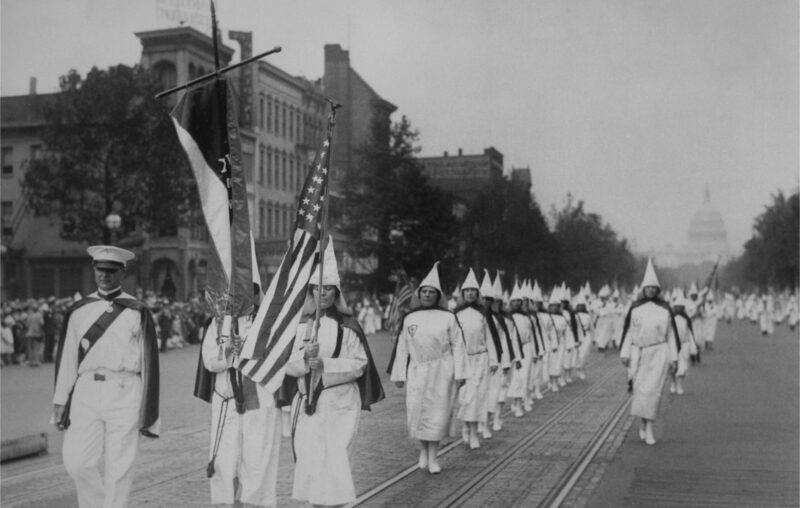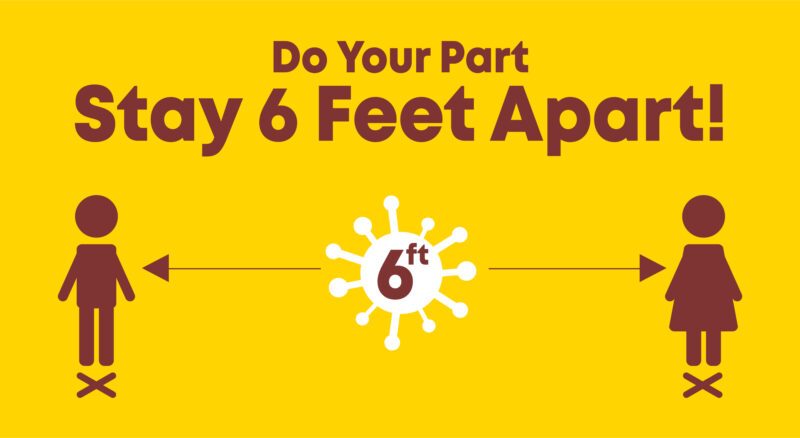Disease Is the Newest Excuse for Segregation

Walking through several airports to catch planes this week, I stepped on hundreds of stickers with the exhortation “Keep a Safe Distance. Stay 6 Feet Apart.”

It’s just a silly sticker at this point, an embarrassing relic of the great 2020 disease panic during which our usual sensibility that people have inherent dignity and rights was displaced by the phobia that human beings are mere disease vectors and spreaders of killer germs.
There was never any science behind it. “It’s almost like it was pulled out of thin air,” Linsey Marr of Virginia Tech told the New York Times (which miraculously printed the comment).
By now, no one pays attention to these exhortations. It’s an impossible rule to follow. We are used to hearing and reading it and strangely overlook it as the latest goofy thing.
The truth is more serious. The notion that separation is safer than integration is dangerous and contrary to the good life as we’ve come to understand it over half a millennium.
Staying separate as a slogan has gradually mutated into a whole philosophy of life, one with a pernicious history and deeply troubling implications for social life. The idea that we can separate in order to stay clean has found its way into some of the more grim policies of our history, including eugenics, Jim Crow laws, segregation, and much more.
The vaccine passport adds to the idea that we – the rich, the privileged, the medically certified as clean – can gather with each other, while excluding the unclean, the poor, the uncertified, the unvaccinated. If we do this, we can live better healthier lives. Keep people apart, they say, and the pathogens can’t get to us.
If you think this is a caricature or an exaggeration, consider the recent writings of a person whom I would argue is the nation’s most influential lockdowner, Donald J. McNeil, Jr. He was the New York Times reporter most responsible for ginning up disease panic back in late February 2020. He has an authoritative-sounding voice. He has journalistic experience but no medical training. Still he seems to know what he is talking about, so when he predicted 4-plus million deaths in the US from SARS-CoV-2, people got very scared.
The Times gave him the platform he needed. He has since been fired from the Times, not for his preposterously irresponsible “journalism” but for saying an inappropriate word while on a Times-sponsored student trip to Peru in 2019. Since then, he has started his own Medium account. I’m glad for that because he can thereby reveal all.
As it turns out, the Times was restraining him. I wish there were more polite terms but now we can discover the real truth: what he favors would wreck life as we know it.
Consider his latest blast: Ground the Planes. He is not kidding. “What may be the most effective way to stop huge surges in infections during a pandemic?” he asks. “Ground the planes.”
Not the next pandemic. This one. Now.
“Last Thanksgiving, I actually did write a note suggesting this to the editors of The New York Times editorial page. It was deemed a bit crazy,” he admits. “I don’t think it is.”
The whole piece gets weirder and weirder. He doesn’t want to stop travel just for now. He wants to stop it permanently, including driving in cars from state to state. Not just for the coronavirus but for purposes of all disease prevention.
Listen to this:
Normally, viruses tend to stay within networks of people.
We know this from many diseases, including H.I.V. — it can enter a country like Kenya, Thailand or the United States and smolder along for a while at a low level, undetected. Then, suddenly, when it hits a network where there is lots of unprotected sex or lots of sharing of contaminated needles, it can explode to infect the majority of those in that network. Famous studies of sex workers in Nairobi, drug injectors in Bangkok and gay men in San Francisco have demonstrated that again and again.
But the virus often then stays largely within that network. It does not necessarily spread to the rest of the population.
We see that with other viruses too — even ones that are far easier to transmit than H.I.V. The more insular the community, the most likely the virus is to stay contained. The last polio outbreak in the United States, in 1979, stayed largely within the Amish communities who had imported it from a global Mennonite convocation. The 2019 measles outbreak in New York City and its suburbs stayed almost entirely within the ultra-Orthodox Jewish community even as [it] travelled back and forth between Brooklyn and other ultra-Orthodox communities in Israel, Britain and Ukraine.
Even SARS-CoV-2, despite being globally disseminated, and for which there was no vaccine until fairly recently, has spread through networks.
It is well-known that, in the first wave in New York City in the spring of 2020, the virus hit some communities especially hard, including black and Hispanic New Yorkers with front-line jobs. But it also hit Hasidic Jews, who had just celebrated Purim together. It hit Filipino nurses, who often worked in hospitals and nursing homes short on personal protective gear. It hit ambulance crews of all races who had to transport the sick. It hit transit workers of all races. And so on.
Outside of New York City that spring, it hit almost nowhere in the Mountain States — except in one unique type of setting: skiers and ski resort workers in Sun Valley, Idaho; Vail, Colorado and a dozen other Rocky Mountain ski towns fell sick and died. Presumably, that was the virus moving from the Italian and Austrian Alps to America using wealthy skiers as vectors.
Normally, networks don’t cross very much. People tend to hang out with like-minded people. Hasidic Jews attend services with Hasidic Jews, ambulance drivers eat lunch with other ambulance drivers, skiers drink mulled wine with other skiers, sorority sisters and fraternity brothers attend the same parties, and so on.
But mass gatherings send diseases leaping from one network to another. Historically, the hajj to Mecca has spread many epidemics, including cholera and polio. A Catholic youth conference in Australia in July 2008 — high flu season in Australia — remixed influenza strains all over the world.
When we cancel basketball games and cruise ship sailings, we recognize that mass gatherings are dangerous. But those are fairly localized.
We need to recognize that mass gatherings on a national scale are even more dangerous. Events like spring break are just the kinds of opportunities that viruses seek out. We would be smart to get ahead of them however we can. Cutting off or tightly constraining air travel at crucial moments could be one way to accomplish that. Hard as it would be on some parts of the economy, a failure of our vaccines would be far harder on our nascent recovery and send us rapidly backwards.
I quote the whole passage just so that you know I’m not exaggerating. What we have here is a completely different worldview from that which built modernity. There is always a pathogen. There is always a new pathogen. There is always a bug, a germ, and sickness, and yes, they can always spread and they do, which is one reason we have such strong immune systems. We’ve embraced exposure, through trade, travel, socializing, and mixing.
His theory, in contrast, is that we shouldn’t mix. Jews in a small community should stay there. Same with Islam: this Mecca pilgrimage has to go. So too with Catholic international events. The Amish should keep their diseases to themselves. (His obsession with religious groups here is a special kind of pathogen.)
Don’t leave your community. Don’t leave your kind. Break all networks. Stop physical gatherings. Use the law to keep people only among their own kind. This is the path to help. Let’s just call the plan extreme physical distancing. It’s the reductio ad absurdum of what we’ve been through for the last year. Leave it to McNeil to take the logic all the way through to the end, to romanticize a world in which life was short, boring, and brutal.
To celebrate this amounts to a rejection of almost all progress in civilization since the end of the Middle Ages, when roads became passable, when people first could leave their feudal estates, when people obtained money and could make choices of where and with whom they wanted to live.
I suspect that McNeil would not regard this as a criticism. He is the author of the earlier pro-lockdown blast from the New York Times (February 28, 2020): “To Take On the Coronavirus, Go Medieval on It.”
“The medieval way, inherited from the era of the Black Death, is brutal,” he explained in what is surely one of the most astonishing articles ever printed by the paper. “Close the borders, quarantine the ships, pen terrified citizens up inside their poisoned cities.”
His latest call fully to reinstate state-managed segregation of everyone only completes that vision.
Sunetra Gupta is fond of saying that we need to completely rethink our relationship between each other, our political order, and the presence of pathogens. Long ago, we evolved an implicit social contract. We would grant human rights, the freedom to travel and mix, to risk exposure in exchange for the possibility of progress, to live with new pathogens in exchange for which we gradually realize the ideal of universal human dignity.
The answer is not fear, not segregation, not lockdowns, not the imposition of medieval rules and castes. The answer is freedom and human rights. Somehow those institutions served us well over many hundreds of years, during which time the human population has mixed ever more, and has grown ever healthier with longer lives. The segregationist path will doom us all.











